Comprehensive Analysis: University Workplace Gender Relation Report
VerifiedAdded on 2020/02/24
|18
|2568
|45
Report
AI Summary
This report provides a detailed analysis of gender relations within a university, utilizing various statistical and visual aids to examine the employment landscape. The report explores parameters such as gender, salary, academic qualifications, job roles, and mode of transport across different campuses. It begins with an overview of salary distribution, revealing a mildly negatively skewed pattern and campus-wise variations, with BNE exhibiting the highest average salary and most equitable distribution. The analysis extends to the relationship between age and salary, revealing a weak positive correlation, and investigates the association between gender, job roles, and salary, highlighting disparities in salary levels and job profiles across different campuses. Furthermore, the report examines the experience levels of employees, showing that most employees have 3-6 years of experience, and also includes analysis of mode of transport used by employees on various campuses. The report uses descriptive statistics, charts, and tables to support its findings and identify areas for improvement in terms of gender neutrality and equitable employment practices.

TITLE PAGE
Student name
Student Id
continued over page
Student name
Student Id
continued over page
Paraphrase This Document
Need a fresh take? Get an instant paraphrase of this document with our AI Paraphraser
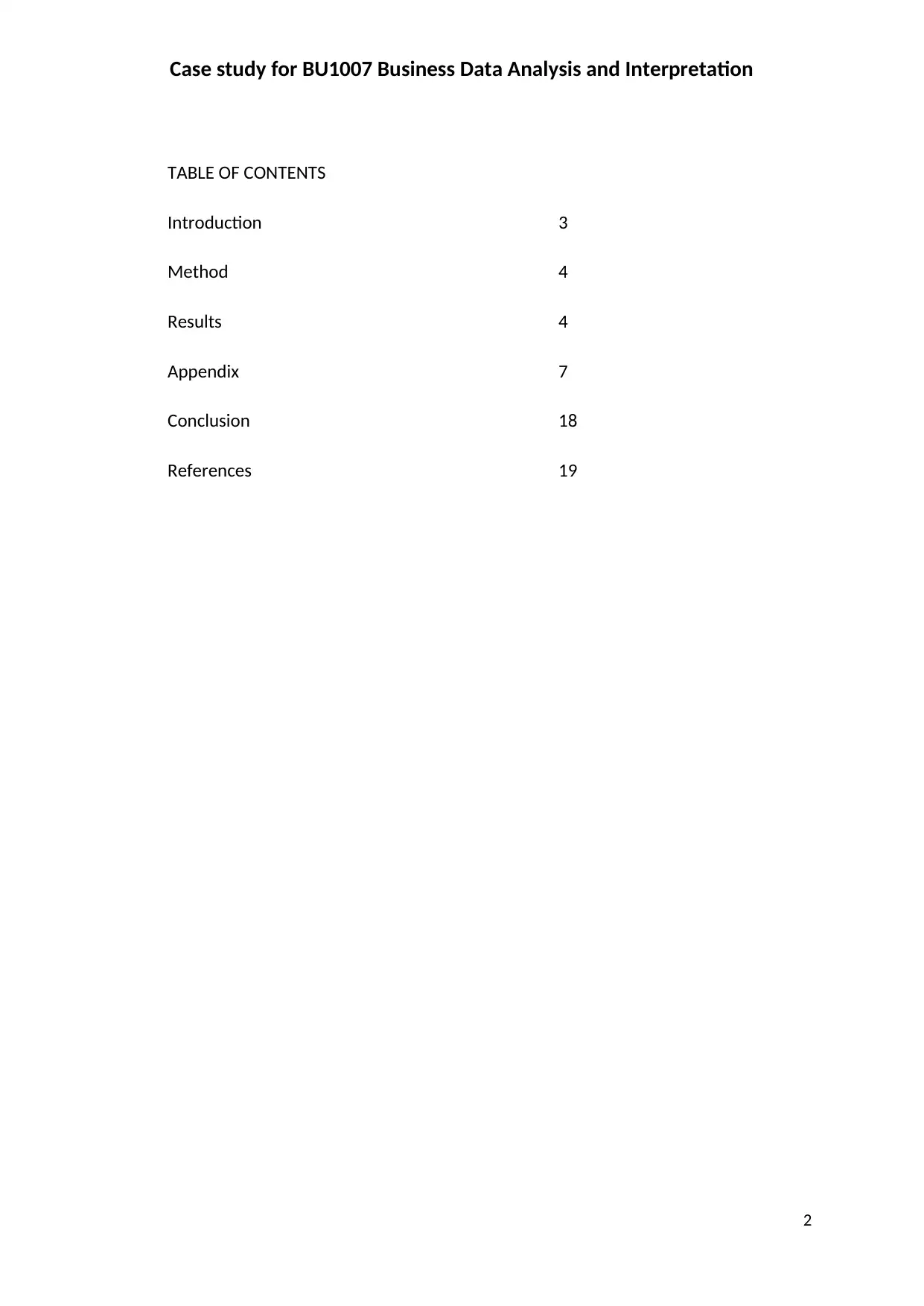
Case study for BU1007 Business Data Analysis and Interpretation
TABLE OF CONTENTS
Introduction 3
Method 4
Results 4
Appendix 7
Conclusion 18
References 19
2
TABLE OF CONTENTS
Introduction 3
Method 4
Results 4
Appendix 7
Conclusion 18
References 19
2
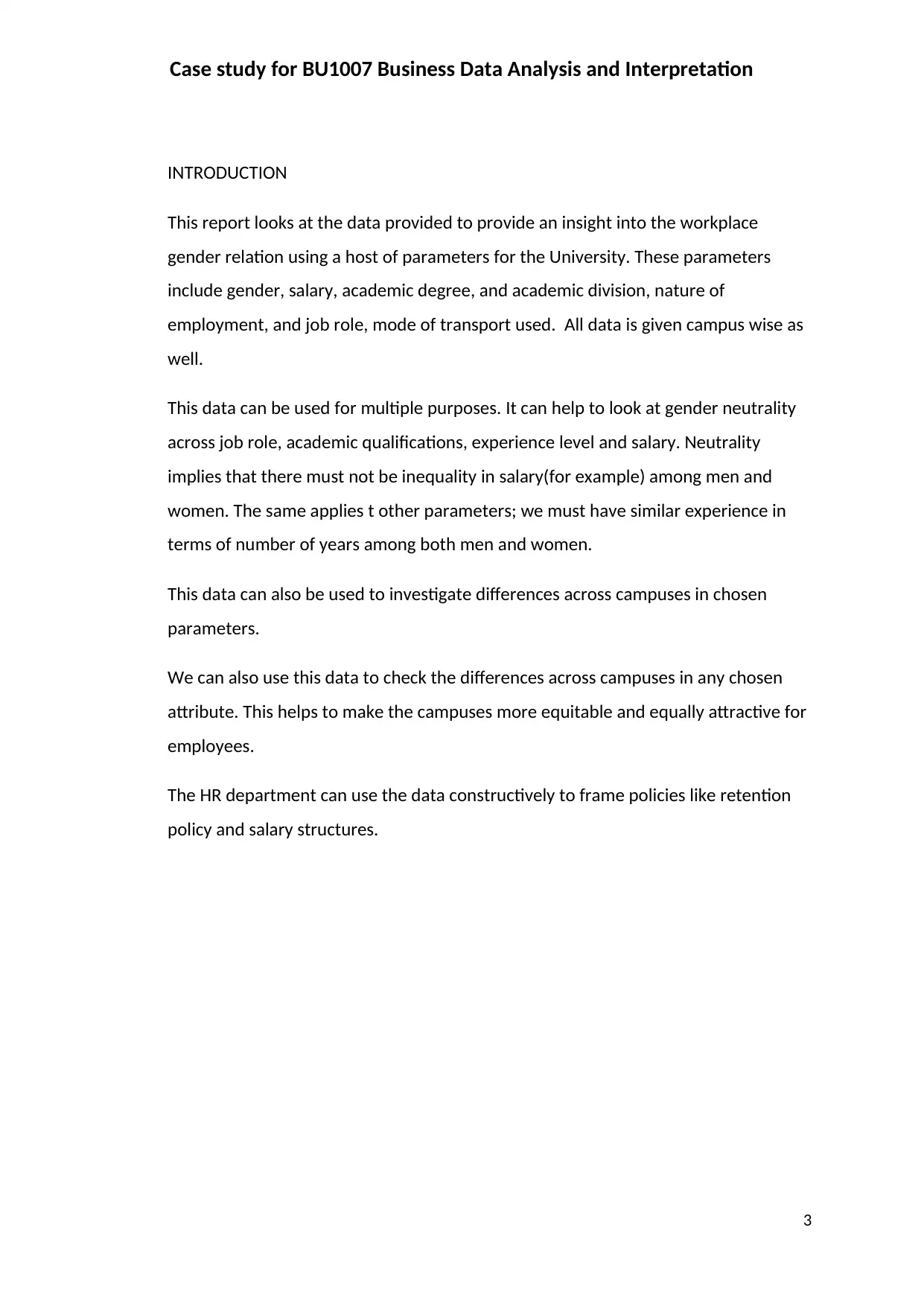
Case study for BU1007 Business Data Analysis and Interpretation
INTRODUCTION
This report looks at the data provided to provide an insight into the workplace
gender relation using a host of parameters for the University. These parameters
include gender, salary, academic degree, and academic division, nature of
employment, and job role, mode of transport used. All data is given campus wise as
well.
This data can be used for multiple purposes. It can help to look at gender neutrality
across job role, academic qualifications, experience level and salary. Neutrality
implies that there must not be inequality in salary(for example) among men and
women. The same applies t other parameters; we must have similar experience in
terms of number of years among both men and women.
This data can also be used to investigate differences across campuses in chosen
parameters.
We can also use this data to check the differences across campuses in any chosen
attribute. This helps to make the campuses more equitable and equally attractive for
employees.
The HR department can use the data constructively to frame policies like retention
policy and salary structures.
3
INTRODUCTION
This report looks at the data provided to provide an insight into the workplace
gender relation using a host of parameters for the University. These parameters
include gender, salary, academic degree, and academic division, nature of
employment, and job role, mode of transport used. All data is given campus wise as
well.
This data can be used for multiple purposes. It can help to look at gender neutrality
across job role, academic qualifications, experience level and salary. Neutrality
implies that there must not be inequality in salary(for example) among men and
women. The same applies t other parameters; we must have similar experience in
terms of number of years among both men and women.
This data can also be used to investigate differences across campuses in chosen
parameters.
We can also use this data to check the differences across campuses in any chosen
attribute. This helps to make the campuses more equitable and equally attractive for
employees.
The HR department can use the data constructively to frame policies like retention
policy and salary structures.
3
⊘ This is a preview!⊘
Do you want full access?
Subscribe today to unlock all pages.

Trusted by 1+ million students worldwide
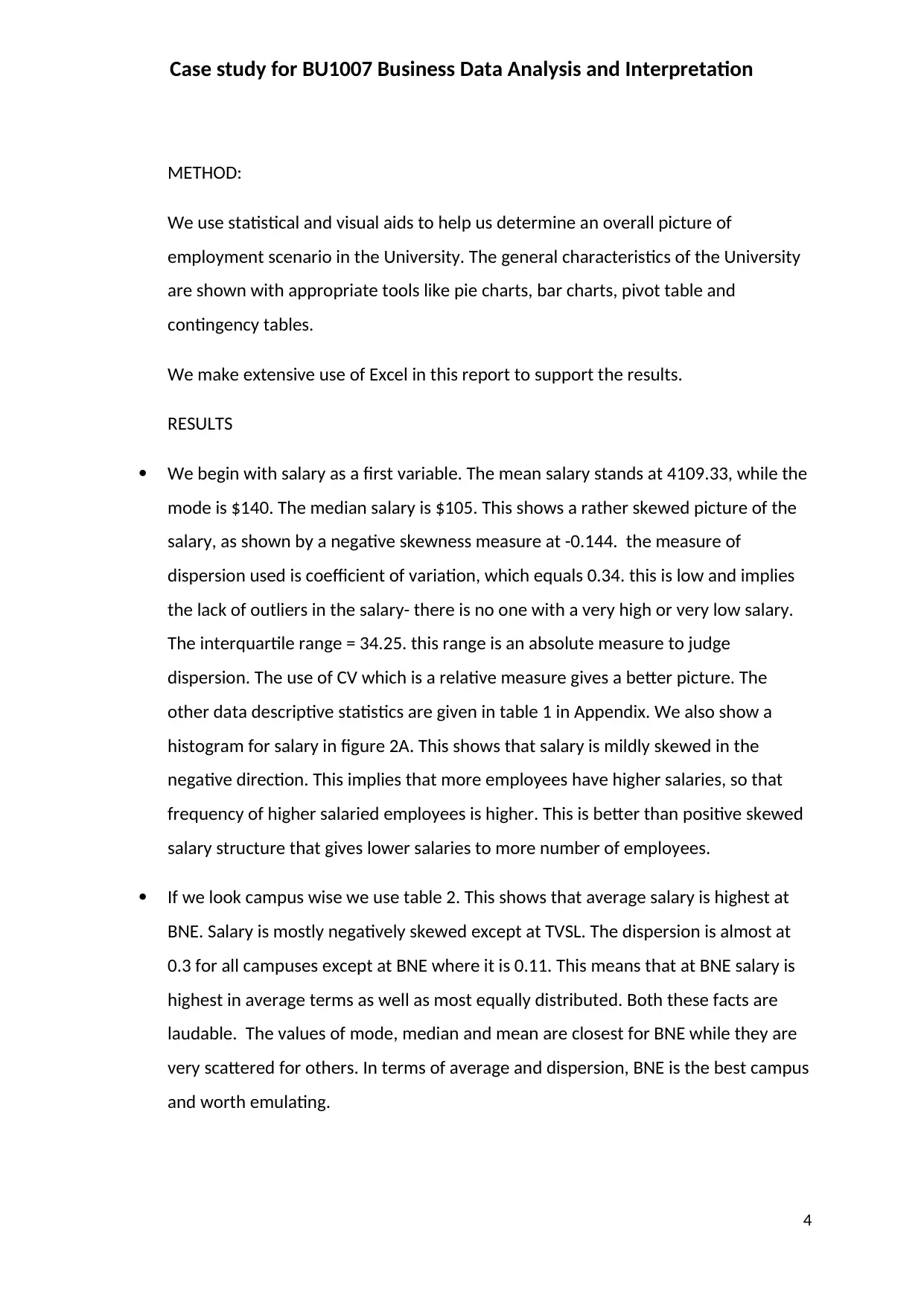
Case study for BU1007 Business Data Analysis and Interpretation
METHOD:
We use statistical and visual aids to help us determine an overall picture of
employment scenario in the University. The general characteristics of the University
are shown with appropriate tools like pie charts, bar charts, pivot table and
contingency tables.
We make extensive use of Excel in this report to support the results.
RESULTS
We begin with salary as a first variable. The mean salary stands at 4109.33, while the
mode is $140. The median salary is $105. This shows a rather skewed picture of the
salary, as shown by a negative skewness measure at -0.144. the measure of
dispersion used is coefficient of variation, which equals 0.34. this is low and implies
the lack of outliers in the salary- there is no one with a very high or very low salary.
The interquartile range = 34.25. this range is an absolute measure to judge
dispersion. The use of CV which is a relative measure gives a better picture. The
other data descriptive statistics are given in table 1 in Appendix. We also show a
histogram for salary in figure 2A. This shows that salary is mildly skewed in the
negative direction. This implies that more employees have higher salaries, so that
frequency of higher salaried employees is higher. This is better than positive skewed
salary structure that gives lower salaries to more number of employees.
If we look campus wise we use table 2. This shows that average salary is highest at
BNE. Salary is mostly negatively skewed except at TVSL. The dispersion is almost at
0.3 for all campuses except at BNE where it is 0.11. This means that at BNE salary is
highest in average terms as well as most equally distributed. Both these facts are
laudable. The values of mode, median and mean are closest for BNE while they are
very scattered for others. In terms of average and dispersion, BNE is the best campus
and worth emulating.
4
METHOD:
We use statistical and visual aids to help us determine an overall picture of
employment scenario in the University. The general characteristics of the University
are shown with appropriate tools like pie charts, bar charts, pivot table and
contingency tables.
We make extensive use of Excel in this report to support the results.
RESULTS
We begin with salary as a first variable. The mean salary stands at 4109.33, while the
mode is $140. The median salary is $105. This shows a rather skewed picture of the
salary, as shown by a negative skewness measure at -0.144. the measure of
dispersion used is coefficient of variation, which equals 0.34. this is low and implies
the lack of outliers in the salary- there is no one with a very high or very low salary.
The interquartile range = 34.25. this range is an absolute measure to judge
dispersion. The use of CV which is a relative measure gives a better picture. The
other data descriptive statistics are given in table 1 in Appendix. We also show a
histogram for salary in figure 2A. This shows that salary is mildly skewed in the
negative direction. This implies that more employees have higher salaries, so that
frequency of higher salaried employees is higher. This is better than positive skewed
salary structure that gives lower salaries to more number of employees.
If we look campus wise we use table 2. This shows that average salary is highest at
BNE. Salary is mostly negatively skewed except at TVSL. The dispersion is almost at
0.3 for all campuses except at BNE where it is 0.11. This means that at BNE salary is
highest in average terms as well as most equally distributed. Both these facts are
laudable. The values of mode, median and mean are closest for BNE while they are
very scattered for others. In terms of average and dispersion, BNE is the best campus
and worth emulating.
4
Paraphrase This Document
Need a fresh take? Get an instant paraphrase of this document with our AI Paraphraser
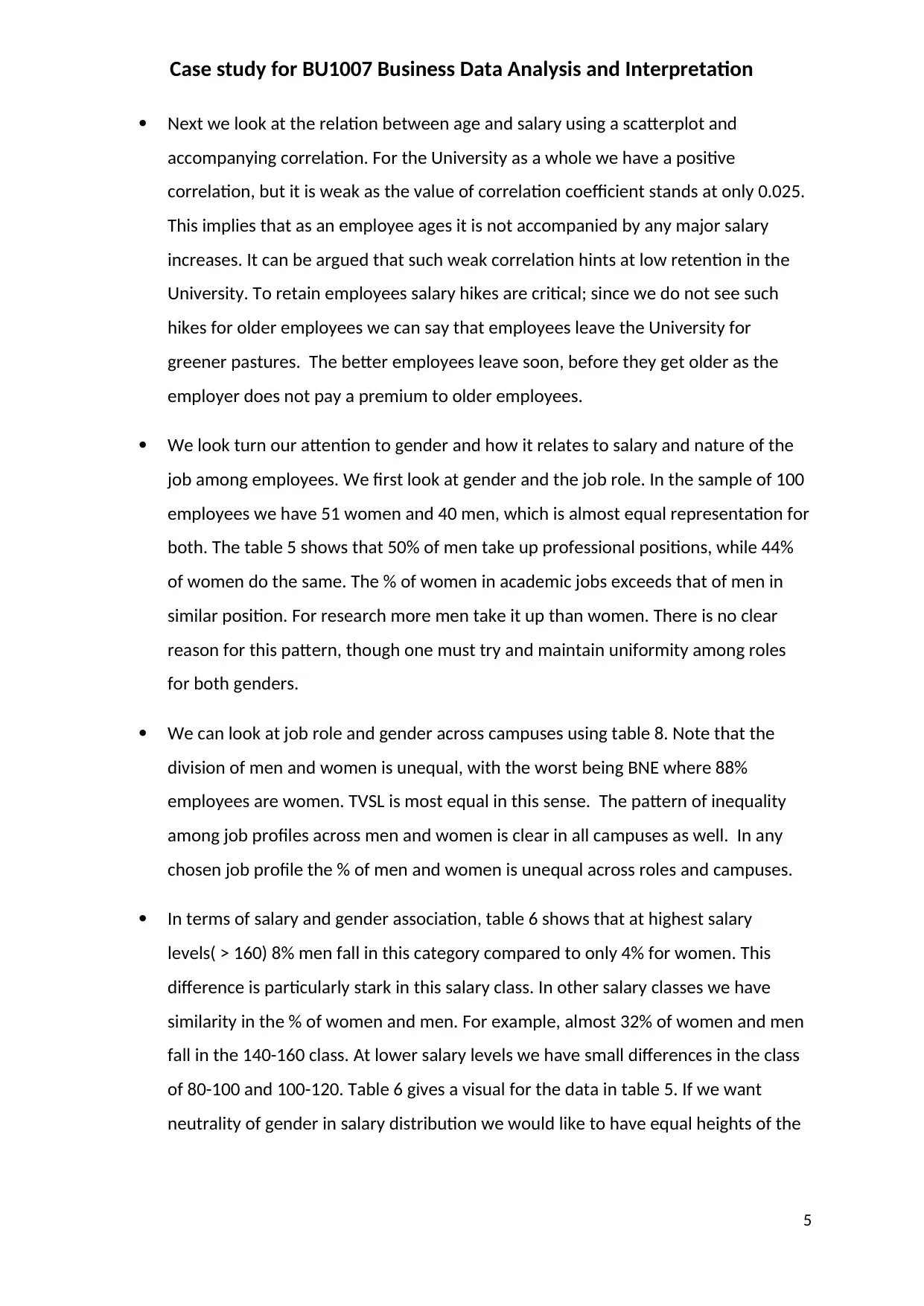
Case study for BU1007 Business Data Analysis and Interpretation
Next we look at the relation between age and salary using a scatterplot and
accompanying correlation. For the University as a whole we have a positive
correlation, but it is weak as the value of correlation coefficient stands at only 0.025.
This implies that as an employee ages it is not accompanied by any major salary
increases. It can be argued that such weak correlation hints at low retention in the
University. To retain employees salary hikes are critical; since we do not see such
hikes for older employees we can say that employees leave the University for
greener pastures. The better employees leave soon, before they get older as the
employer does not pay a premium to older employees.
We look turn our attention to gender and how it relates to salary and nature of the
job among employees. We first look at gender and the job role. In the sample of 100
employees we have 51 women and 40 men, which is almost equal representation for
both. The table 5 shows that 50% of men take up professional positions, while 44%
of women do the same. The % of women in academic jobs exceeds that of men in
similar position. For research more men take it up than women. There is no clear
reason for this pattern, though one must try and maintain uniformity among roles
for both genders.
We can look at job role and gender across campuses using table 8. Note that the
division of men and women is unequal, with the worst being BNE where 88%
employees are women. TVSL is most equal in this sense. The pattern of inequality
among job profiles across men and women is clear in all campuses as well. In any
chosen job profile the % of men and women is unequal across roles and campuses.
In terms of salary and gender association, table 6 shows that at highest salary
levels( > 160) 8% men fall in this category compared to only 4% for women. This
difference is particularly stark in this salary class. In other salary classes we have
similarity in the % of women and men. For example, almost 32% of women and men
fall in the 140-160 class. At lower salary levels we have small differences in the class
of 80-100 and 100-120. Table 6 gives a visual for the data in table 5. If we want
neutrality of gender in salary distribution we would like to have equal heights of the
5
Next we look at the relation between age and salary using a scatterplot and
accompanying correlation. For the University as a whole we have a positive
correlation, but it is weak as the value of correlation coefficient stands at only 0.025.
This implies that as an employee ages it is not accompanied by any major salary
increases. It can be argued that such weak correlation hints at low retention in the
University. To retain employees salary hikes are critical; since we do not see such
hikes for older employees we can say that employees leave the University for
greener pastures. The better employees leave soon, before they get older as the
employer does not pay a premium to older employees.
We look turn our attention to gender and how it relates to salary and nature of the
job among employees. We first look at gender and the job role. In the sample of 100
employees we have 51 women and 40 men, which is almost equal representation for
both. The table 5 shows that 50% of men take up professional positions, while 44%
of women do the same. The % of women in academic jobs exceeds that of men in
similar position. For research more men take it up than women. There is no clear
reason for this pattern, though one must try and maintain uniformity among roles
for both genders.
We can look at job role and gender across campuses using table 8. Note that the
division of men and women is unequal, with the worst being BNE where 88%
employees are women. TVSL is most equal in this sense. The pattern of inequality
among job profiles across men and women is clear in all campuses as well. In any
chosen job profile the % of men and women is unequal across roles and campuses.
In terms of salary and gender association, table 6 shows that at highest salary
levels( > 160) 8% men fall in this category compared to only 4% for women. This
difference is particularly stark in this salary class. In other salary classes we have
similarity in the % of women and men. For example, almost 32% of women and men
fall in the 140-160 class. At lower salary levels we have small differences in the class
of 80-100 and 100-120. Table 6 gives a visual for the data in table 5. If we want
neutrality of gender in salary distribution we would like to have equal heights of the
5
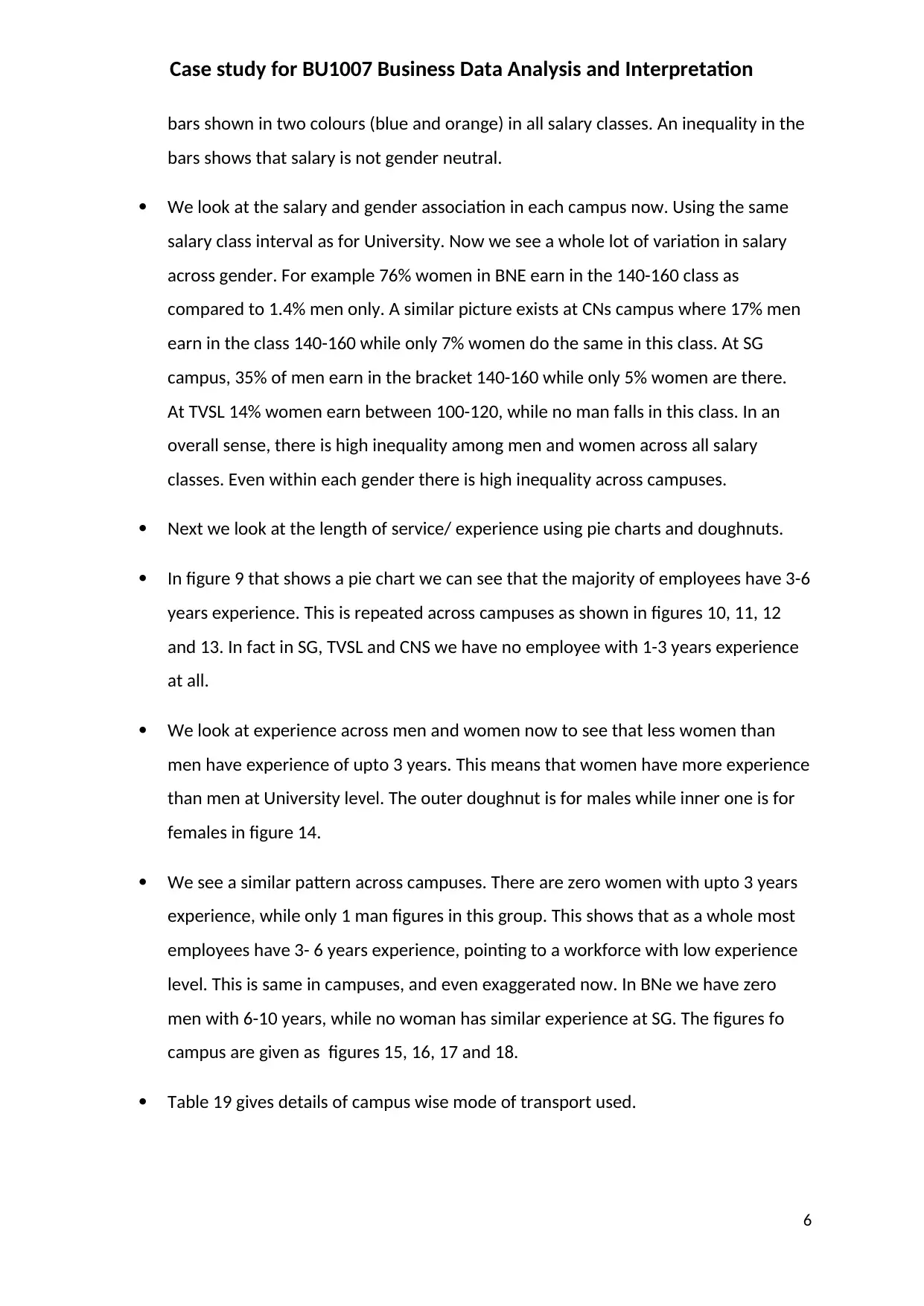
Case study for BU1007 Business Data Analysis and Interpretation
bars shown in two colours (blue and orange) in all salary classes. An inequality in the
bars shows that salary is not gender neutral.
We look at the salary and gender association in each campus now. Using the same
salary class interval as for University. Now we see a whole lot of variation in salary
across gender. For example 76% women in BNE earn in the 140-160 class as
compared to 1.4% men only. A similar picture exists at CNs campus where 17% men
earn in the class 140-160 while only 7% women do the same in this class. At SG
campus, 35% of men earn in the bracket 140-160 while only 5% women are there.
At TVSL 14% women earn between 100-120, while no man falls in this class. In an
overall sense, there is high inequality among men and women across all salary
classes. Even within each gender there is high inequality across campuses.
Next we look at the length of service/ experience using pie charts and doughnuts.
In figure 9 that shows a pie chart we can see that the majority of employees have 3-6
years experience. This is repeated across campuses as shown in figures 10, 11, 12
and 13. In fact in SG, TVSL and CNS we have no employee with 1-3 years experience
at all.
We look at experience across men and women now to see that less women than
men have experience of upto 3 years. This means that women have more experience
than men at University level. The outer doughnut is for males while inner one is for
females in figure 14.
We see a similar pattern across campuses. There are zero women with upto 3 years
experience, while only 1 man figures in this group. This shows that as a whole most
employees have 3- 6 years experience, pointing to a workforce with low experience
level. This is same in campuses, and even exaggerated now. In BNe we have zero
men with 6-10 years, while no woman has similar experience at SG. The figures fo
campus are given as figures 15, 16, 17 and 18.
Table 19 gives details of campus wise mode of transport used.
6
bars shown in two colours (blue and orange) in all salary classes. An inequality in the
bars shows that salary is not gender neutral.
We look at the salary and gender association in each campus now. Using the same
salary class interval as for University. Now we see a whole lot of variation in salary
across gender. For example 76% women in BNE earn in the 140-160 class as
compared to 1.4% men only. A similar picture exists at CNs campus where 17% men
earn in the class 140-160 while only 7% women do the same in this class. At SG
campus, 35% of men earn in the bracket 140-160 while only 5% women are there.
At TVSL 14% women earn between 100-120, while no man falls in this class. In an
overall sense, there is high inequality among men and women across all salary
classes. Even within each gender there is high inequality across campuses.
Next we look at the length of service/ experience using pie charts and doughnuts.
In figure 9 that shows a pie chart we can see that the majority of employees have 3-6
years experience. This is repeated across campuses as shown in figures 10, 11, 12
and 13. In fact in SG, TVSL and CNS we have no employee with 1-3 years experience
at all.
We look at experience across men and women now to see that less women than
men have experience of upto 3 years. This means that women have more experience
than men at University level. The outer doughnut is for males while inner one is for
females in figure 14.
We see a similar pattern across campuses. There are zero women with upto 3 years
experience, while only 1 man figures in this group. This shows that as a whole most
employees have 3- 6 years experience, pointing to a workforce with low experience
level. This is same in campuses, and even exaggerated now. In BNe we have zero
men with 6-10 years, while no woman has similar experience at SG. The figures fo
campus are given as figures 15, 16, 17 and 18.
Table 19 gives details of campus wise mode of transport used.
6
⊘ This is a preview!⊘
Do you want full access?
Subscribe today to unlock all pages.

Trusted by 1+ million students worldwide
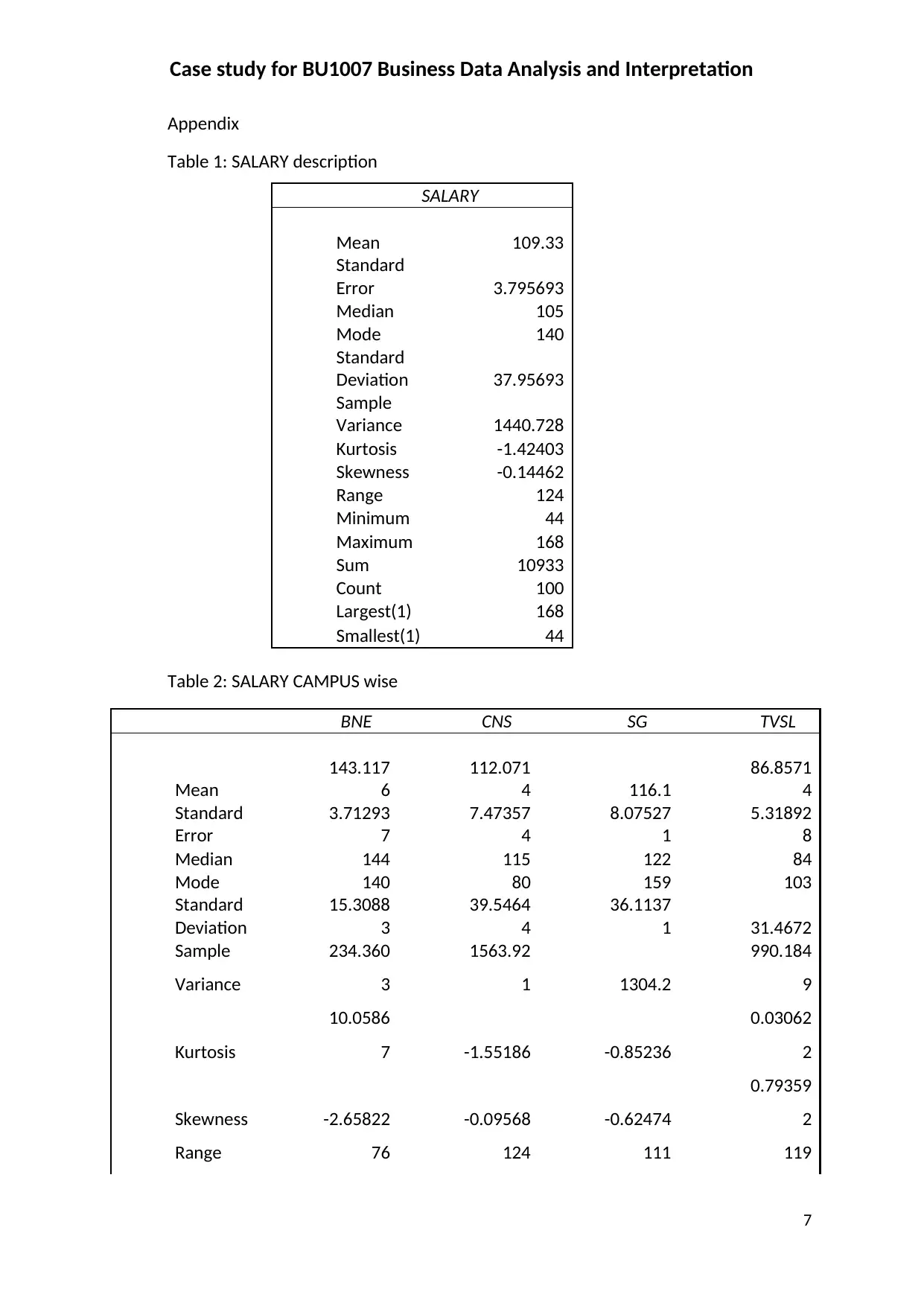
Case study for BU1007 Business Data Analysis and Interpretation
Appendix
Table 1: SALARY description
Table 2: SALARY CAMPUS wise
BNE CNS SG TVSL
Mean
143.117
6
112.071
4 116.1
86.8571
4
Standard
Error
3.71293
7
7.47357
4
8.07527
1
5.31892
8
Median 144 115 122 84
Mode 140 80 159 103
Standard
Deviation
15.3088
3
39.5464
4
36.1137
1 31.4672
Sample
Variance
234.360
3
1563.92
1 1304.2
990.184
9
Kurtosis
10.0586
7 -1.55186 -0.85236
0.03062
2
Skewness -2.65822 -0.09568 -0.62474
0.79359
2
Range 76 124 111 119
7
SALARY
Mean 109.33
Standard
Error 3.795693
Median 105
Mode 140
Standard
Deviation 37.95693
Sample
Variance 1440.728
Kurtosis -1.42403
Skewness -0.14462
Range 124
Minimum 44
Maximum 168
Sum 10933
Count 100
Largest(1) 168
Smallest(1) 44
Appendix
Table 1: SALARY description
Table 2: SALARY CAMPUS wise
BNE CNS SG TVSL
Mean
143.117
6
112.071
4 116.1
86.8571
4
Standard
Error
3.71293
7
7.47357
4
8.07527
1
5.31892
8
Median 144 115 122 84
Mode 140 80 159 103
Standard
Deviation
15.3088
3
39.5464
4
36.1137
1 31.4672
Sample
Variance
234.360
3
1563.92
1 1304.2
990.184
9
Kurtosis
10.0586
7 -1.55186 -0.85236
0.03062
2
Skewness -2.65822 -0.09568 -0.62474
0.79359
2
Range 76 124 111 119
7
SALARY
Mean 109.33
Standard
Error 3.795693
Median 105
Mode 140
Standard
Deviation 37.95693
Sample
Variance 1440.728
Kurtosis -1.42403
Skewness -0.14462
Range 124
Minimum 44
Maximum 168
Sum 10933
Count 100
Largest(1) 168
Smallest(1) 44
Paraphrase This Document
Need a fresh take? Get an instant paraphrase of this document with our AI Paraphraser
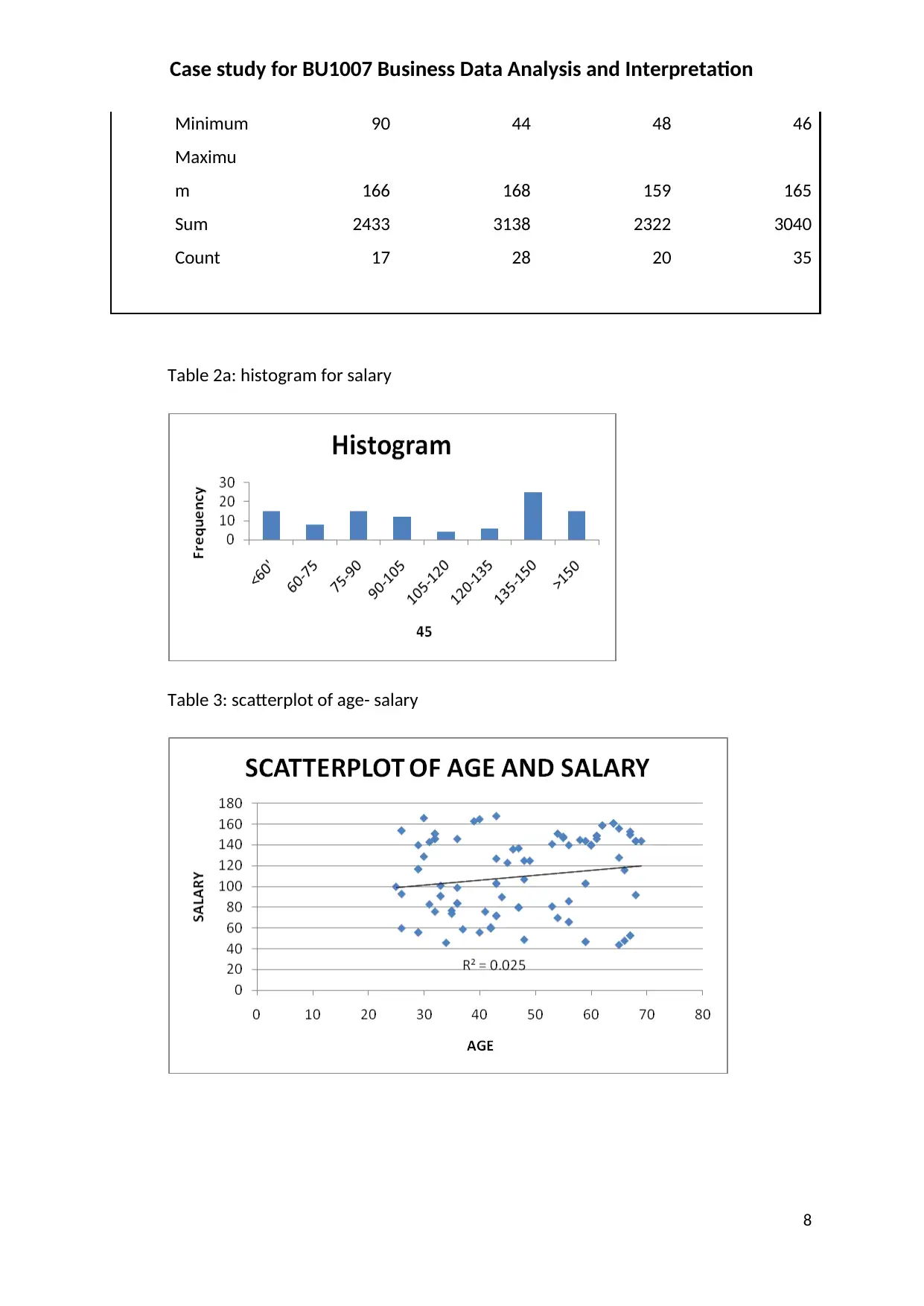
Case study for BU1007 Business Data Analysis and Interpretation
Minimum 90 44 48 46
Maximu
m 166 168 159 165
Sum 2433 3138 2322 3040
Count 17 28 20 35
Table 2a: histogram for salary
Table 3: scatterplot of age- salary
8
Minimum 90 44 48 46
Maximu
m 166 168 159 165
Sum 2433 3138 2322 3040
Count 17 28 20 35
Table 2a: histogram for salary
Table 3: scatterplot of age- salary
8
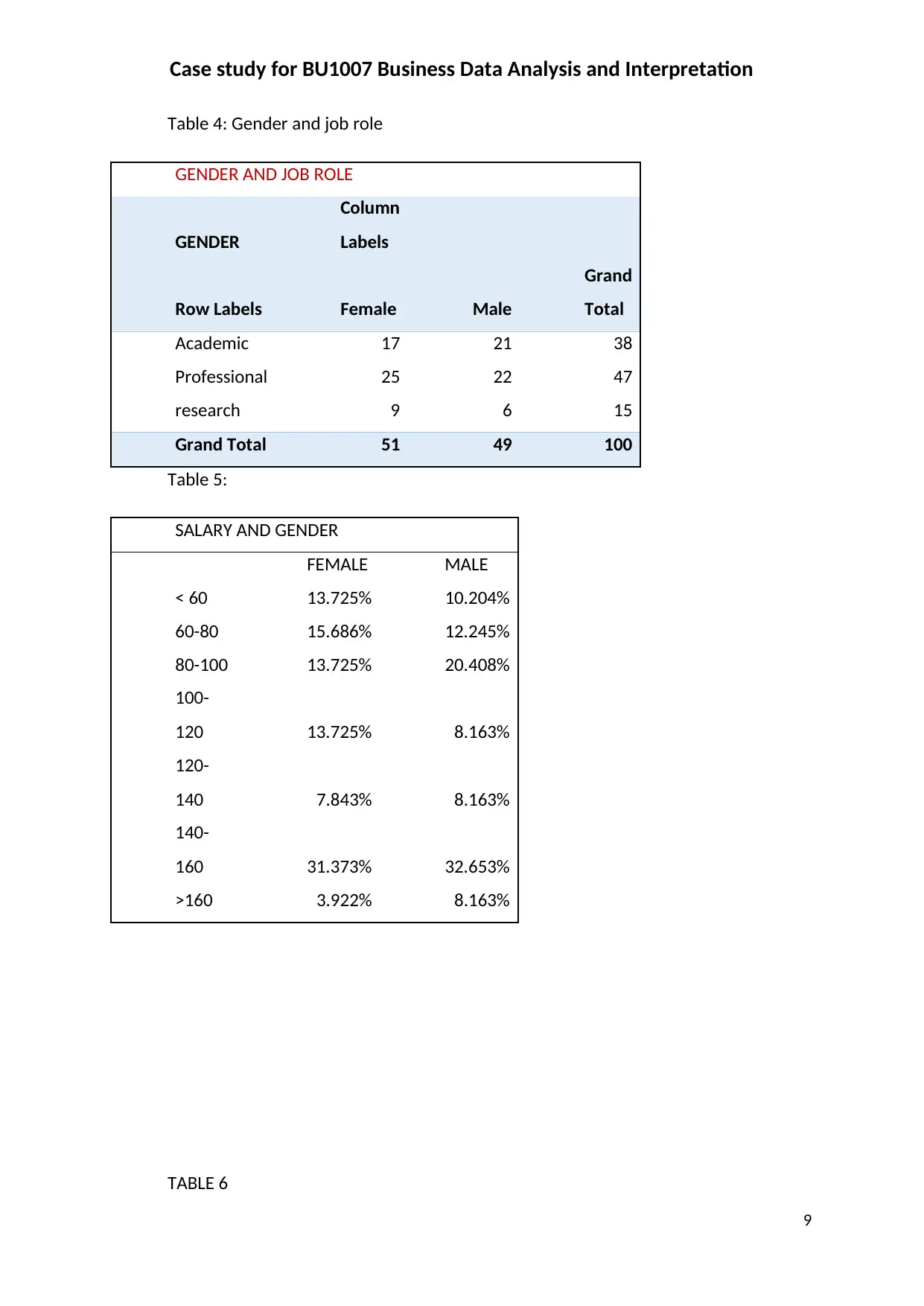
Case study for BU1007 Business Data Analysis and Interpretation
Table 4: Gender and job role
GENDER AND JOB ROLE
GENDER
Column
Labels
Row Labels Female Male
Grand
Total
Academic 17 21 38
Professional 25 22 47
research 9 6 15
Grand Total 51 49 100
Table 5:
SALARY AND GENDER
FEMALE MALE
< 60 13.725% 10.204%
60-80 15.686% 12.245%
80-100 13.725% 20.408%
100-
120 13.725% 8.163%
120-
140 7.843% 8.163%
140-
160 31.373% 32.653%
>160 3.922% 8.163%
TABLE 6
9
Table 4: Gender and job role
GENDER AND JOB ROLE
GENDER
Column
Labels
Row Labels Female Male
Grand
Total
Academic 17 21 38
Professional 25 22 47
research 9 6 15
Grand Total 51 49 100
Table 5:
SALARY AND GENDER
FEMALE MALE
< 60 13.725% 10.204%
60-80 15.686% 12.245%
80-100 13.725% 20.408%
100-
120 13.725% 8.163%
120-
140 7.843% 8.163%
140-
160 31.373% 32.653%
>160 3.922% 8.163%
TABLE 6
9
⊘ This is a preview!⊘
Do you want full access?
Subscribe today to unlock all pages.

Trusted by 1+ million students worldwide
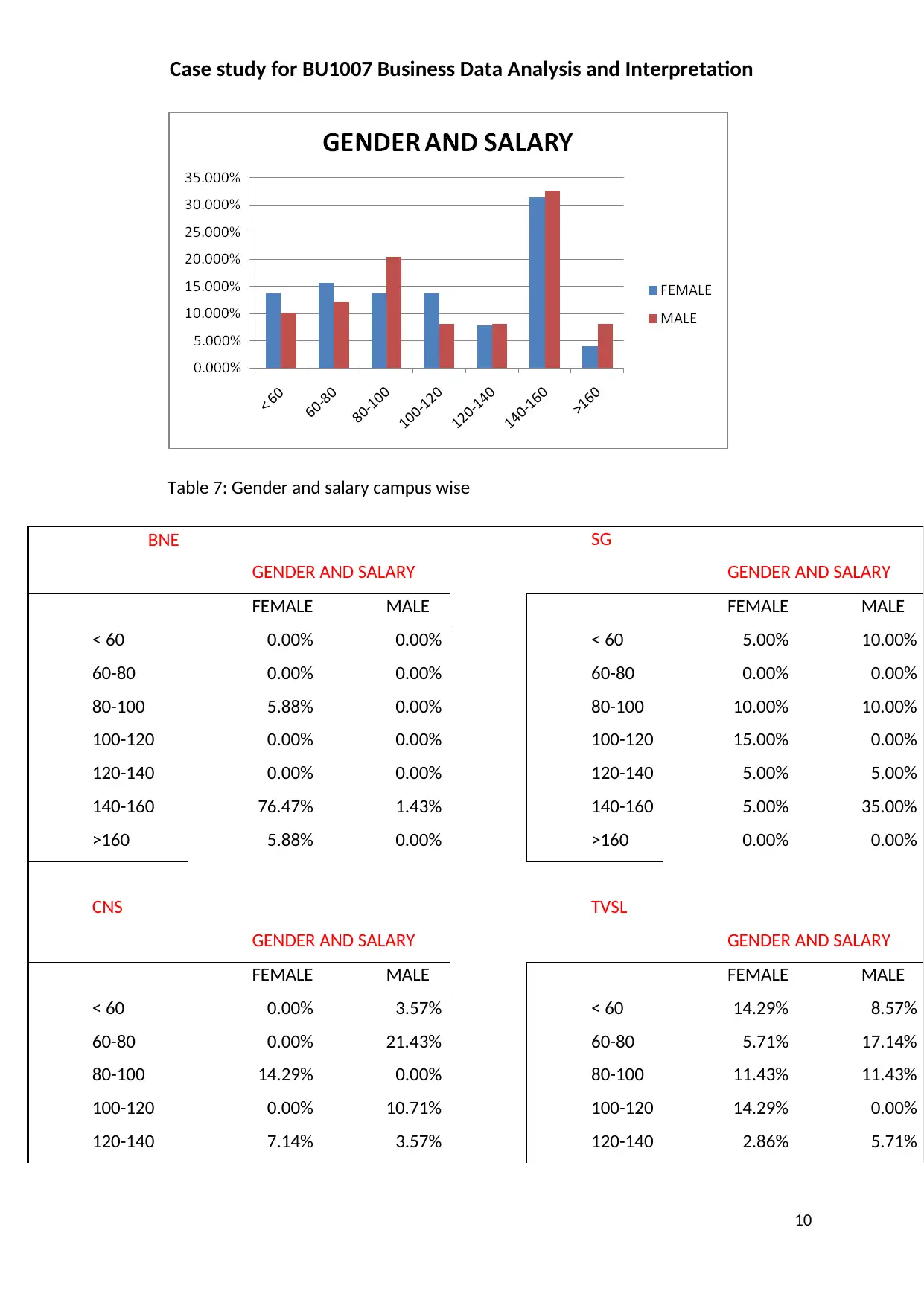
Case study for BU1007 Business Data Analysis and Interpretation
Table 7: Gender and salary campus wise
BNE SG
GENDER AND SALARY GENDER AND SALARY
FEMALE MALE FEMALE MALE
< 60 0.00% 0.00% < 60 5.00% 10.00%
60-80 0.00% 0.00% 60-80 0.00% 0.00%
80-100 5.88% 0.00% 80-100 10.00% 10.00%
100-120 0.00% 0.00% 100-120 15.00% 0.00%
120-140 0.00% 0.00% 120-140 5.00% 5.00%
140-160 76.47% 1.43% 140-160 5.00% 35.00%
>160 5.88% 0.00% >160 0.00% 0.00%
CNS TVSL
GENDER AND SALARY GENDER AND SALARY
FEMALE MALE FEMALE MALE
< 60 0.00% 3.57% < 60 14.29% 8.57%
60-80 0.00% 21.43% 60-80 5.71% 17.14%
80-100 14.29% 0.00% 80-100 11.43% 11.43%
100-120 0.00% 10.71% 100-120 14.29% 0.00%
120-140 7.14% 3.57% 120-140 2.86% 5.71%
10
Table 7: Gender and salary campus wise
BNE SG
GENDER AND SALARY GENDER AND SALARY
FEMALE MALE FEMALE MALE
< 60 0.00% 0.00% < 60 5.00% 10.00%
60-80 0.00% 0.00% 60-80 0.00% 0.00%
80-100 5.88% 0.00% 80-100 10.00% 10.00%
100-120 0.00% 0.00% 100-120 15.00% 0.00%
120-140 0.00% 0.00% 120-140 5.00% 5.00%
140-160 76.47% 1.43% 140-160 5.00% 35.00%
>160 5.88% 0.00% >160 0.00% 0.00%
CNS TVSL
GENDER AND SALARY GENDER AND SALARY
FEMALE MALE FEMALE MALE
< 60 0.00% 3.57% < 60 14.29% 8.57%
60-80 0.00% 21.43% 60-80 5.71% 17.14%
80-100 14.29% 0.00% 80-100 11.43% 11.43%
100-120 0.00% 10.71% 100-120 14.29% 0.00%
120-140 7.14% 3.57% 120-140 2.86% 5.71%
10
Paraphrase This Document
Need a fresh take? Get an instant paraphrase of this document with our AI Paraphraser

Case study for BU1007 Business Data Analysis and Interpretation
140-160 7.14% 17.86% 140-160 2.86% 2.86%
>160 7.14% 7.14% >160 0.00% 2.86%
Table 8:
BNE
Female Male
Academic 5.88% 0.00%
Professional 64.71% 11.76%
research 17.65% 0.00%
Grand Total 88.24% 0.00%
CNS
Female Male
Academic 10.53% 25.00%
Professional 21.43% 21.43%
research 0.00% 17.86%
Grand Total 35.71% 64.29%
SG
Female Male
Academic 15.0% 30.0%
Professional 15.0% 30.0%
research 10.0% 0.0%
Grand Total 40.0% 60.0%
TVSL
Row Labels Female Male
Academic 25.71% 22.86%
Professional 14.29% 22.86%
research 11.43% 2.86%
11
140-160 7.14% 17.86% 140-160 2.86% 2.86%
>160 7.14% 7.14% >160 0.00% 2.86%
Table 8:
BNE
Female Male
Academic 5.88% 0.00%
Professional 64.71% 11.76%
research 17.65% 0.00%
Grand Total 88.24% 0.00%
CNS
Female Male
Academic 10.53% 25.00%
Professional 21.43% 21.43%
research 0.00% 17.86%
Grand Total 35.71% 64.29%
SG
Female Male
Academic 15.0% 30.0%
Professional 15.0% 30.0%
research 10.0% 0.0%
Grand Total 40.0% 60.0%
TVSL
Row Labels Female Male
Academic 25.71% 22.86%
Professional 14.29% 22.86%
research 11.43% 2.86%
11
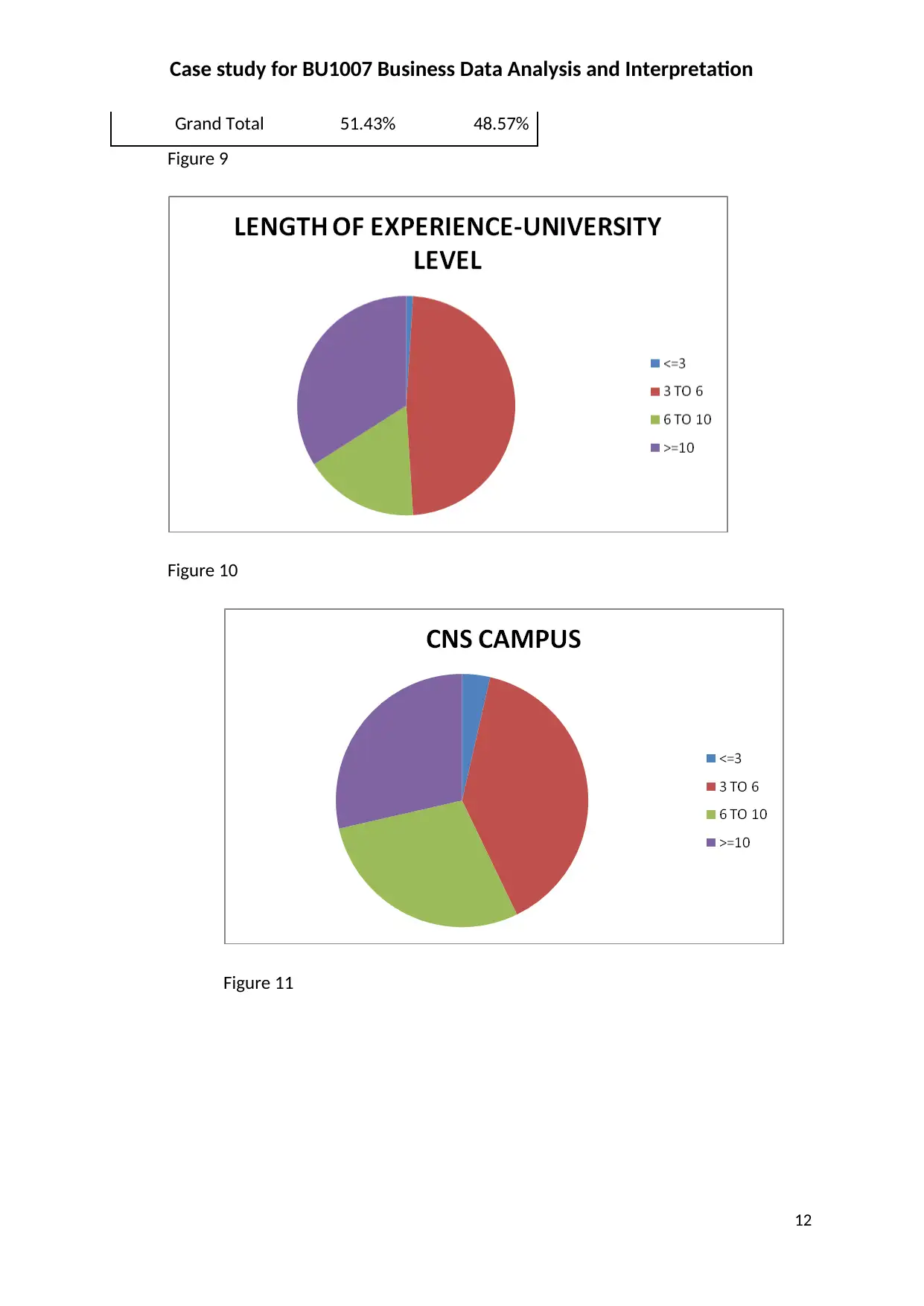
Case study for BU1007 Business Data Analysis and Interpretation
Grand Total 51.43% 48.57%
Figure 9
Figure 10
Figure 11
12
Grand Total 51.43% 48.57%
Figure 9
Figure 10
Figure 11
12
⊘ This is a preview!⊘
Do you want full access?
Subscribe today to unlock all pages.

Trusted by 1+ million students worldwide
1 out of 18
Related Documents
Your All-in-One AI-Powered Toolkit for Academic Success.
+13062052269
info@desklib.com
Available 24*7 on WhatsApp / Email
![[object Object]](/_next/static/media/star-bottom.7253800d.svg)
Unlock your academic potential
Copyright © 2020–2026 A2Z Services. All Rights Reserved. Developed and managed by ZUCOL.




